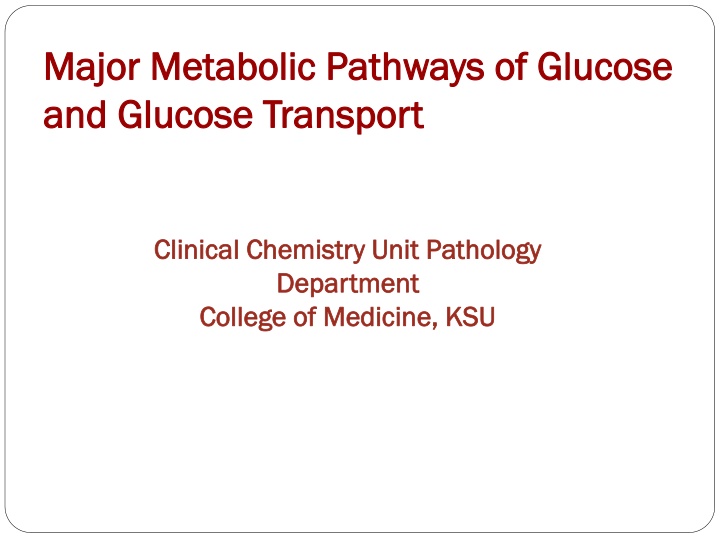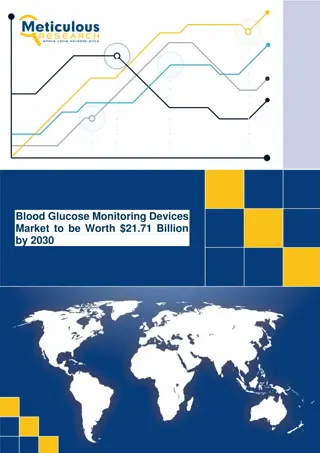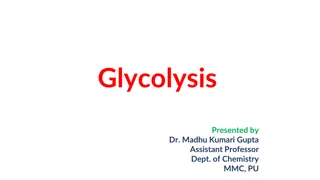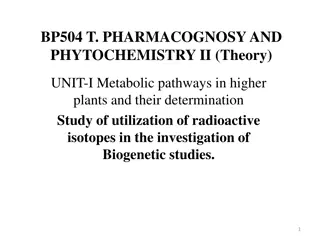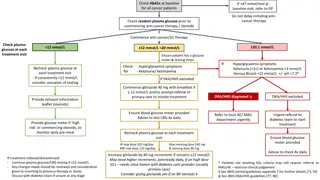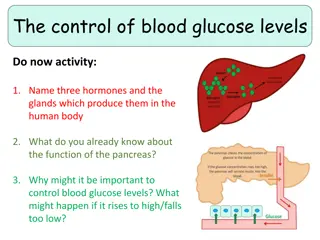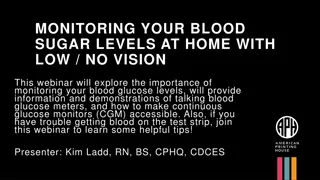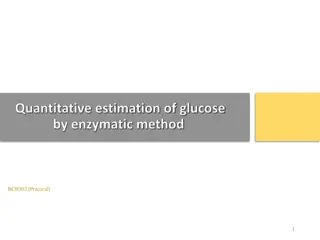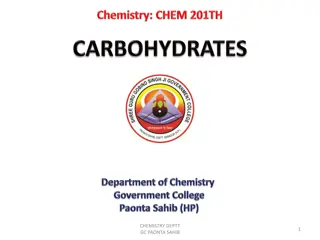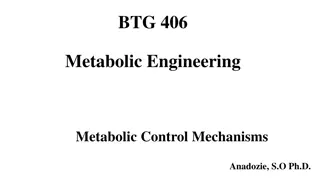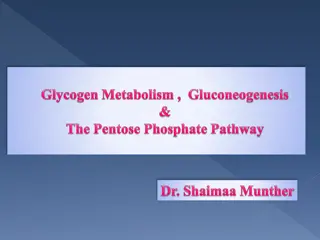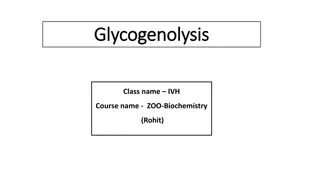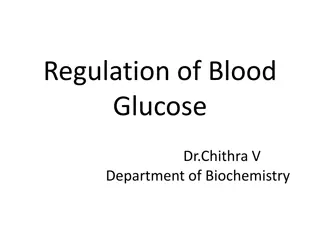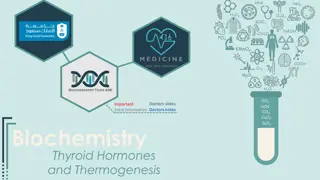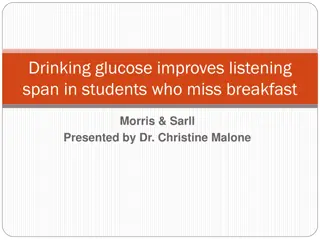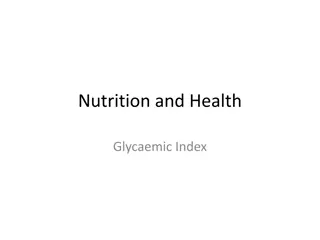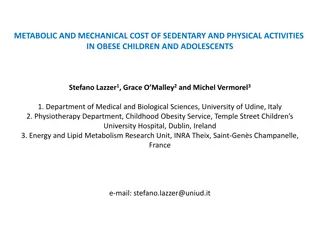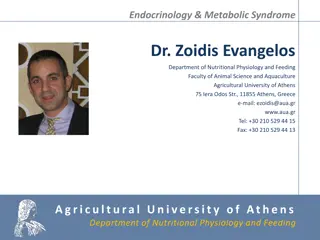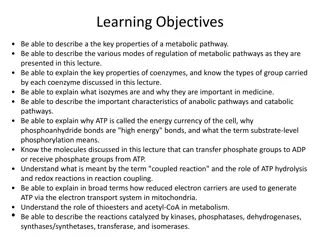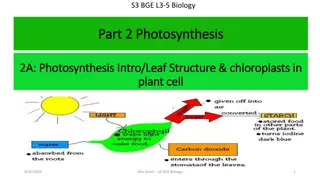Overview of Glucose Metabolic Pathways in Clinical Chemistry
Explore the major metabolic pathways of glucose, including glycogenolysis, gluconeogenesis, glycolysis, and more. Understand the production, utilization, catabolic, and anabolic cycles of glucose in cellular metabolism. Learn about key concepts such as hexose interconversion, HMP/PPP, Krebs cycle, and regulatory mechanisms. Recognize the importance of glucose transport and cellular reactions in energy production. Dive into the oxidation of glucose through glycolysis and its outcomes in aerobic and anaerobic conditions.
Download Presentation

Please find below an Image/Link to download the presentation.
The content on the website is provided AS IS for your information and personal use only. It may not be sold, licensed, or shared on other websites without obtaining consent from the author.If you encounter any issues during the download, it is possible that the publisher has removed the file from their server.
You are allowed to download the files provided on this website for personal or commercial use, subject to the condition that they are used lawfully. All files are the property of their respective owners.
The content on the website is provided AS IS for your information and personal use only. It may not be sold, licensed, or shared on other websites without obtaining consent from the author.
E N D
Presentation Transcript
Major Metabolic Pathways of Glucose Major Metabolic Pathways of Glucose and Glucose Transport and Glucose Transport Clinical Chemistry Unit Pathology Clinical Chemistry Unit Pathology Department Department College of Medicine, KSU College of Medicine, KSU
Objectives By the end of the lecture, students are By the end of the lecture, students are expected to: expected to: Define a metabolic pathway. Define a metabolic pathway. Describe the general metabolic pathways for Describe the general metabolic pathways for glucose (production and utilization) glucose (production and utilization) Briefly describe the HMP Briefly describe the HMP Recognize the mechanisms of glucose transport Recognize the mechanisms of glucose transport
Metabolic Pathway Definition Definition Site: Site: Reactions Reactions Rate Rate- -limiting enzyme(s) limiting enzyme(s) Regulatory mechanism(s): Regulatory mechanism(s): Cellular (tissue) and Subcellular Cellular (tissue) and Subcellular Rapid, Rapid, short short- -term Slow, Slow, long long- -term term term Covalent Covalent modification modification Allosteric Allosteric Induction/repression Induction/repression
Metabolic Pathways of Glucose- production and utilization Glycogenolysis Glycogenolysis Hexose Hexose interconversion interconversion Gluconeogenesis Gluconeogenesis Production Production Glucose Utilization Utilization Glycolysis Glycolysis HMP/PPP HMP/PPP Hexose interconversion Hexose interconversion Glycogenesis Glycogenesis Krebs cycle Krebs cycle
Metabolic Pathways of Glucose- catabolic and anabolic Catabolic cycles Catabolic cycles Glycolysis Glycolysis (Mainly) Krebs Krebs (Mainly) Glycogenolysis Glycogenolysis HMP HMP Anabolic cycles Anabolic cycles Gluconeogenesis Gluconeogenesis Glycogenesis Glycogenesis (Mainly) (Mainly)
Glycolysis Oxidation of glucose to provide energy. Pyruvate is the end product of glycolysis in cells with mitochondria and an adequate supply of oxygen- aerobic glycolysis In absence of oxygen and in cells that lack mitochondria, the end product is lactate- anaerobic glycolysis
Glycogenesis and Glycogenolysis Glycogenesis: Glycogenesis: Synthesis of glycogen from glucose Synthesis of glycogen from glucose Mainly liver and muscle, Cytosol Mainly liver and muscle, Cytosol Glycogenolysis Glycogenolysis Degradation of glycogen into glucose Degradation of glycogen into glucose Mainly liver and muscle, Cytosol Mainly liver and muscle, Cytosol
Gluconeogenesis Synthesis of glucose from non-carbohydrate precursors. The precursors could be lactate, pyruvate, glycerol and alpha-keto acids. It requires both mitochondria and cytosolic enzymes Liver and kidney
Hexose Monophosphate shunt(HMP) or Pentose Phosphate Pathway (PPP) HMP shunt is an alternative pathway of glucose oxidation It is not involved in the generation of energy Around 10% of glucose is entered in this pathway In liver and kidney, this percentage is upto 30%
Biomedical Importance It has two main functions- 1. Provides NADPH which is required for synthesis of fatty acids, steroid and some amino acids Detoxification of drugs by cytochrome p450 In scavenging the free radicals 2. Provides Pentoses This pentose and its derivatives are useful in the synthesis of Nucleic acids (DNA and RNA) Nucleotides (ATP, NAD, FAD and CoA)
Tissue Distribution Location- Cytosol Liver Lactating mammary gland Adrenal cortex Gonads Adipose tissue Erythrocytes to reduce glutathione Lens and cornea
Phases of HMP Shunt It has two phases- Oxidative phase Non-oxidative phase
Enzymes numbered above are: 1, 2) glucose 6-phosphate dehydrogenase and6-phosphogluconolactone hydrolase, 3) 6-phosphogluconate dehydrogenase, 4) ribose 5-phosphate isomerase, 5) phosphopentose epimerase, 6 and 8) transketolase (coenzyme: thiamine pyrophosphate), and 7) transaldolase.
Phase 1- Oxidative pathway G6PD- Glucose 6-Phosphate Dehydrogenase Lactonase- 6 phosphogluconolactone hydrolase 6PGD- 6 phosphogluconate dehydrogenase Source wordpress.com
Phase 2- Non-oxidative a) Interconversion of pentoses
Phase 2- Non-oxidative a) Conversion of pentose phosphate to hexose phosphates
Glucose Transport Na+-Monosaccharide Cotransporter: Against concentration gradient Energy dependent Carrier-mediated Coupled to Na+ transport Small intestine, renal tubules & choroid plexus Na+-Independent Facilitated Diffusion: Down the concentration gradient Energy Independent Glucose Transporters (GLUT 1-14)
Glucose Transporters Tissue Tissue- -specific expression pattern specific expression pattern GLUT GLUT- -1 1 GLUT GLUT- -2 2 GLUT GLUT- -3 3 GLUT GLUT- -4 4 GLUT GLUT- -5 5 GLUT GLUT- -7 7 Functions: Functions: GLUT GLUT- -1, 3 & 4 1, 3 & 4 Glucose uptake from blood Glucose uptake from blood GLUT GLUT- -2 2 GLUT GLUT- -5 5 RBCs and brain RBCs and brain Liver, kidney & pancreas Liver, kidney & pancreas Neurons Neurons Adipose tissue & skeletal Adipose tissue & skeletal muscle muscle Small intestine & testes Small intestine & testes Liver (ER Liver (ER- -membrane) membrane) Blood & cells (either direction) Blood & cells (either direction) Fructose transport Fructose transport
Take Home Messsage There are multiple pathways for glucose that can be grouped in to catabolic (utilizing glucose) or anabolic (producing glucose) Glycolysis is the major metabolic pathway of glucose breakdown to provide energy
Take Home Messsage - HMP Alternative pathway for glucose oxidation but not meant for producing energy Has two phases- oxidative and non-oxidative During oxidative phase, glucose-6-P is oxidized with generation of 2 moles of NADPH, and one mole of pentose phosphate, with liberation of CO2 During non-oxidative phase, pentose phosphate is converted to intermediates of glycolysis
References Lippincott s Illustrated Reviews- Biochemistry 6th Edition- pages: 96-97,117,126,128,145-147 http://www.biochemden.com/the-hexose-monophosphate- shunt/
Non Oxidative phase 5 reactions Ribu 5P=R5P, Ribu 5P= X5P, Isomerase Epimerase X5P + R5P= Sedo 7P + G3P, Sedo 7P + G3P = Ery4P + F6P, X5P + Ery4P = F6P + G3P, TK TA TK (10) (10) (9) R5P- Nucleotide biosynthesis G3P and F6P- Glycolytic intermediates
